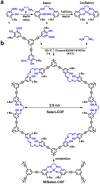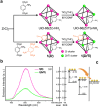Pore engineering in metal-organic frameworks and covalent organic frameworks: strategies and applications
- PMID: 40535720
- PMCID: PMC12172060
- DOI: 10.1039/d5sc01635e
Pore engineering in metal-organic frameworks and covalent organic frameworks: strategies and applications
Abstract
Crystalline porous materials, particularly metal-organic frameworks (MOFs) and covalent organic frameworks (COFs), have garnered significant attention for advanced applications due to their tunable pore environments and versatile functionalities. By precisely controlling factors such as size, shape, functional sites, and pore distribution, MOFs and COFs can be tailored to exhibit high selectivity for specific molecules, making them ideal for applications in gas storage and separation, catalysis, and water remediation. This review provides a background overview, beginning with an introduction to pore surface engineering strategies and the design features of MOFs and COFs. It then highlights recent advancements in three key research areas that our group has investigated in-depth over the past decade, discussing the strategies and principles involved. Finally, we outline the remaining challenges and offer our perspectives on future opportunities for pore-engineered MOFs and COFs.
This journal is © The Royal Society of Chemistry.
Conflict of interest statement
There are no conflicts to declare.
Figures



















Similar articles
-
Reticular Chemistry within Crystalline Porous Gas Adsorbents and Membranes.Acc Chem Res. 2025 Jul 1;58(13):1937-1950. doi: 10.1021/acs.accounts.5c00070. Epub 2025 May 15. Acc Chem Res. 2025. PMID: 40371497
-
Crystalline Porous Frameworks via Hierarchical Dynamic Covalent Assembly.Acc Chem Res. 2025 Aug 18. doi: 10.1021/acs.accounts.5c00393. Online ahead of print. Acc Chem Res. 2025. PMID: 40825208
-
The fusion of metal-organic framework (MOF) and covalent organic framework (COF): A synergistic leap toward bridging boundaries in catalytic, sensing, and biomedical frontiers.Adv Colloid Interface Sci. 2025 Oct;344:103613. doi: 10.1016/j.cis.2025.103613. Epub 2025 Jul 22. Adv Colloid Interface Sci. 2025. PMID: 40714298 Review.
-
Unlocking the Comparative Potential of Porous Frameworks: A Review on MOFs and COFs for Gas Sorption.Top Curr Chem (Cham). 2025 Aug 26;383(3):32. doi: 10.1007/s41061-025-00517-9. Top Curr Chem (Cham). 2025. PMID: 40856978 Review.
-
Coating Metal-Organic Frameworks (MOFs) and Associated Composites on Electrodes, Thin Film Polymeric Materials, and Glass Surfaces.Nanomaterials (Basel). 2025 Aug 2;15(15):1187. doi: 10.3390/nano15151187. Nanomaterials (Basel). 2025. PMID: 40801725 Free PMC article. Review.
References
-
- Li Y. Li L. Yu J. Applications of Zeolites in Sustainable Chemistry. Chem. 2017;3:928–949.
Publication types
LinkOut - more resources
Full Text Sources
Miscellaneous

